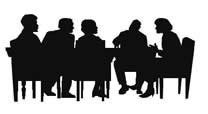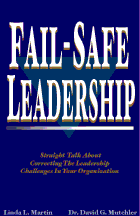Leadership, Back to Basics
 It is often the case that a Board of Directors, whether it is for a Fortune 500 company or a local non-profit, has to recruit and evaluate candidates for the position of CEO or President. When asked what they are looking for during this selection process, the most common answer is leadership. But why do they look for a candidate with leadership skills and how do they determine if that candidate will be an effective leader. Most importantly, they are looking for a person who can accomplish tasks and achieve results. Let’s consider that way first and then two models for determining an individual’s leadership ability.
It is often the case that a Board of Directors, whether it is for a Fortune 500 company or a local non-profit, has to recruit and evaluate candidates for the position of CEO or President. When asked what they are looking for during this selection process, the most common answer is leadership. But why do they look for a candidate with leadership skills and how do they determine if that candidate will be an effective leader. Most importantly, they are looking for a person who can accomplish tasks and achieve results. Let’s consider that way first and then two models for determining an individual’s leadership ability.
Why is Leadership Important?
Until recently, most of the training and education has involved management or administration. Remember that an MBA stands for Master of Business Administration. The primary goal of management is to effectively direct an ongoing operation. This may include the maintenance of controls or procedures to insure against mistakes or a costly loss of productivity and revenue. Managers maintain the status quo. Leaders, on the other hand, are the motivators of change. They are big picture folks, who can see the forest from the trees. They understand change and appreciate the opportunities which it provides.
The Fortune 500 Company lives in a world of dynamic changes. There are changes in technology, customer expectation, and marketing techniques. Many organization in recent memory where unable to recognize and adapt to those changes, causing them great loss and almost extinction. Examples such as Kodak, General Motors and IBM come to mind. Kodak was never able to adapt to the change from film to digital technology. General Motors was not able to adapt to changing customer tastes. IBM was more fortunate in finding a leader like Louis Gerstner Jr., who led IBM  from being a mainframe supplier to a full serve company, saving it from bankruptcy. Gerstner’s book “Who Says Elephants Can’t Dance?” is an important story of a leader who facilitated a major change in a well-established organization.
from being a mainframe supplier to a full serve company, saving it from bankruptcy. Gerstner’s book “Who Says Elephants Can’t Dance?” is an important story of a leader who facilitated a major change in a well-established organization.
Non-profits have a different issue. Their Boards are primarily volunteers who donate their time and skills because to their belief in the organization’s mission. They can advise and oversee, but they cannot be the leader who enables change. The development of the staff and volunteers is left to the day-to-day leader, the President or Executive Director. Our local Chamber of Commerce had for many years been headed by a series of presidents who for the most part, maintained the status quo. As a result, membership was in decline and the staff was always in a state of turn-over. A new person was hired for the position, who looked for new ideas and relished change. As a result, membership is growing again, the staff is involved and committed, and many new programs have been started.
The Leadership Characteristic Model
Over the years, a number of different models for leadership have developed. This article will only cover two general models, the first of which is the Leadership Characteristic Model. This model was developed as a result of studying the personality types and attributes of successful leaders and developing a list of characteristics which make these individual successful. They include attributes such as communication skills, empathy, trustworthiness, and problem solving ability. To the academic, this model is of great interest and opens up hours of debate. But these attributes and characteristics are difficult to measure and may vary in importance depending on the situation. To those who strive to be better leaders, the development of the skills associated with these characteristics is difficult and time consuming.
The Results Based Leadership Model
Remember that we earlier stated that these board members were looking for someone who could accomplish tasks and achieve results? The Results Based Leadership Model is defined by the achievement of results. The achievement of those results involved a process which that leader knows and exercises. We do recognize that in executing that process a leader must utilize some of the competencies included in the Leadership Characteristic Model. The end game, however. is not the development of personal characteristics, but the achievement of results. The product of this second model is highly measurable and the process is simple to learn.
The process itself is that used in Strategic Planning. It involves:
- Determining Core Values
- Working with others, to develop a Vision of the Organization’s future
- Developing an overall approach to achieving that vision through a Mission Statement
- Establishing areas where goals need to be set using Critical Goal Categories
- Writing and prioritizing Goals within each of those critical goal categories.
- Developing the who, what, when and where in Action Plans to achieve those goals
 At the core of the Result Based Model is not just writing a plan, but of equal importance executing that plan, because it’s all about results. I was part of a management team that each year presents their plan along with their budget for the following year for approval by corporate management. At one point, our CEO remarked that we had become very skilled at developing plans, but still need to develop a way to implement them.
At the core of the Result Based Model is not just writing a plan, but of equal importance executing that plan, because it’s all about results. I was part of a management team that each year presents their plan along with their budget for the following year for approval by corporate management. At one point, our CEO remarked that we had become very skilled at developing plans, but still need to develop a way to implement them.
The Results Based Model is concisely and clearly presented in a book by Dr. David Mutchler and Linda Martin entitled Fail-Safe Leadership. You can order that book from us directly at a cost of $15.95 by emailing us a bob@plangoals.com. Because of our continued efforts to develop a more complete understanding of different leadership situations, we offer the book for free to those who agree to meet with us later to provide their insights on the subject. That offer appears on the offer page of our website. Click on this direct link.
